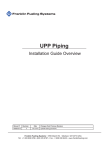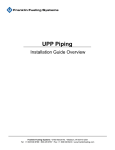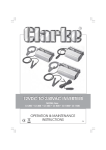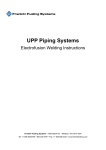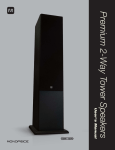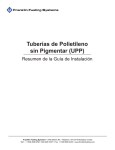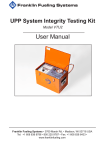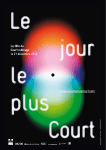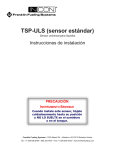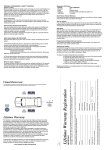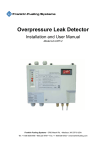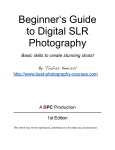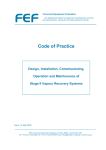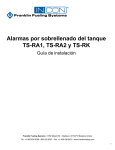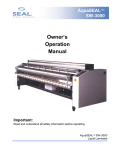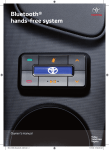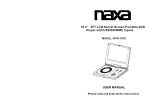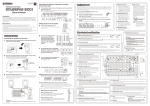Download UPP Piping - Franklin Fueling Systems
Transcript
UPP Piping Installation Guide Overview Manual # 408001016 Revision 4 Date Oct. 2014 Changes from Previous Revision Show EVOH pipe lining for both EN / UL Franklin Fueling Systems • 3760 Marsh Rd. • Madison, WI 53718 USA Tel: +1 608 838 8786 • 800 225 9787 • Fax: +1 608 838 6433 • www.franklinfueling.com Safety Important! UPP Systems must only be installed by fully trained and certified installers. Failure to follow installation instructions will invalidate warranty and installer certification! Piping Installation Safety • UPP Welding Units must never be operated in Zone 1 or Zone 0 areas (Hazardous area definitions are from European Directive 1999/92/ EC and guidelines can be found in the APEA Blue Book 3rd Edition). • Ensure Welding Units are connected to a power supply that meets the requirements detailed in the user manual and are within the requirements of any local authority or regional legislation. • Important to any type of piping system is to safely connect all metallic components to ground. Metallic components, and more general conductive materials, due to their high capacitance, can have the potential to store high amount of electrostatic energy (sparks discharge can only be observed over conductive elements). • All exposed metal parts used in UPP System installations should be adequately grounded to a dedicated earth electrode and brought to a potential equal to that of other metal parts in the close proximity. Chemical Safety • Where using chemicals (such as Acetone) during the installation of UPP systems products, follow all safety guidelines given on the chemical containers themselves or on any accompanying literature. 2 Confined Space • Some installation of UPP products may occur in confined spaces where a lack of oxygen and a concentration of toxic vapors is likely to be experienced. Such working conditions are dangerous and all local health and safety guidelines for working in such environments should be followed. Material Handling Protective Equipment • Ensure the correct personal protective equipment (PPE) is used at all times in line with local health and safety requirements. Material Safety Data • Ensure all safety data is accessed and used while installing UPP Systems (Material Safety Data Sheets are available in the download area of the UPP website). Transport & Storage • UPP products should be transported and stored in accordance with the guidelines contained in this manual. Heavy items • Heavy items should be handled using suitable lifting equipment operated by authorised personnel. Figure 1: Installation Overview Contents Safety.................................................................2 Introduction.......................................................3 Underground Fuel Pipe Construction............... 3 Transit, Off-loading and Storage.....................4 Uncoiling Pipe................................................... 4 Site Preparation................................................5 Pipe Burial Guidelines.....................................5 Pipe Bend Radius............................................. 6 Completion Records......................................... 6 Pipe Detector Tape........................................... 7 Pressure Testing...............................................7 Testing Guidelines. .......................................... 7 UPP Recommended Pipe Test Procedure....... 8 Hydrostatic Pressure Testing Method............... 8 UPP Pneumatic Tightness Testing Method Procedure............................................9 Sump Inspection Register.............................10 Underground Fuel Pipe Construction Black outer structural layer of the pipe is High Density Polyethylene (HDPE), grade PE80 or PE100 which allows the use of electrofusion couplers and fittings to construct a variety of pipeline configurations. HDPE PE80 and PE100 has well proven resistance to: stress cracking, puncture, scratch, impact, microbial and rodent attack. The intermediate tie-layer causes a permanent bond to occur between the polyethylene and the liner material. The liner of UPP primary pipe is a specially formulated “fuel proof” barrier layer manufactured from either EVOH (EN / UL) or Nylon (UL). Both liners have exceptional resistance to absorption and permeation of both hydrocarbon and alcohol fuel blends. The smooth bore and low friction loss of UPP pipe permits higher fuel and vapor flows than steel pipe, reducing the pumping energy costs. UPP underground fuel pipe is pressure rated to 10 bar (EN) or (90 psi) to UL971. Rupture pressure is typically exceeding 40 bar (580 psi) providing a large margin of safety. Carrier - PE - Black Introduction Underground Fuel Pipe Systems Several types of underground fuel pipe are available for different applications and to meet various engineering and legal requirements: • U PP primary pipe a fuel-proof liner for product, suction, pressure, vapor vent and fill lines. • UPP Secondary containment pipe used with EN primary pipe – for pressure systems or environmentally sensitive sites. • U PP Integral Secondary Containment pipe (UL971 spec) — for pressure systems or environmentally sensitive sites. • U PP electrical conduit pipe — for underground electrical wiring protection. • UPP Electrical duct — for underground electrical wiring protection. UPP piping systems are designed in various diameters, from 32-160 mm (I"- 6") for the transfer of fuels in filling station forecourts, marinas, and airports. UPP systems are also used for government and military installations as well as many industrial sites such as mines and rail depots. There is no requirement for a concrete trench because fusion welded HDPE pipe is structurally resistant to weight of backfill material and dynamic traffic loads. Over 30 years experience showing no failures in underground fuel pipe systems and no loss into the ground. Tie Layer Liner - EVOH -clear (EN / UL) Nylon - Yellow (UL) Figure 2: UPP Pipe Structure Pressure Ratings Pressure Rating (UL 971) Pipe type UPP Primary UPP Secondary Pressure Rating (Bar) Pressure Rating (PSI) 6.2 90 5 72.5 Table 1: UL971 Pipe Maximum Pressure Rating Pressure Rating (EN14125) Pipe type Pressure Rating (Bar) Pressure Rating (PSI) UPP Primary 10 145 UPP Secondary 5 72.5 Table 2: EN14125 Pipe Maximum Pressure Rating 3 Transit, Off-loading and Storage Although UPP polyethylene pipe and fittings are extremely hard wearing and resilient, it is important to handle and store them with care to prevent scuffing or gouging. Any damaged pipes may need to be rejected and not installed. UPP products should be transported in a flat-bedded vehicle, free from sharp objects and projections. Wide polypropylene slings must be used when lifting pipe crates by crane. Avoid using chains, hooks or hawsers. A spreading beam should be used when lifting crates containing pipe lengths greater than 6 m (19 ft 8") • U PP fittings - all electrofusion fittings are packed in heat-sealed polyethylene bags and delivered in cardboard cartons. Fittings should be stored in their packaging and in a dry area, away from direct sunlight, until ready for use. This is particularly important for electrofusion fittings. These must be kept in their packaging until ready for use to prevent any contamination or oxidation. Uncoiling Pipe • Allow for a slight bending of the pipe crates when on and off-loading. • S tandard 6 m (19 ft 8") crates may be moved using a forklift. A side loader fitted with a minimum of four supporting forks should be used for longer lengths. Otherwise use a crane fitted with a spreader beam. • W hen using a forklift to on or off-load coils, the forks should be covered to avoid damage to the coiled pipe. Figure 4: Uncoiling Pipe The pipe can straighten with considerable force. Take care when releasing pipe from the coil and secure the straightened pipe. Let the pipe rest in its uncoiled state for about eight hours. High ambient temperatures can reduce this “layout” time and low temperatures may increase it. Pipe can be laid in its final position to “relax” before connecting up. Caution Figure 3: Moving Coils Storage on site • Individual pipe lengths should be stacked not more than 1 m (3 ft) high with the bottom layer fully restrained by wedges. The bottom layer of pipes should be laid on timber battens at 1 m (3 ft) centres to avoid any damage from sharp objects lying on the ground. • P ipe crates should be stored on clear, level ground and should never be stacked more than three crates high. • C oils should be stored on firm level ground that has suitable protection for the bottom of the coil. Stacked coils should never exceed three coils high. Individual coils should be stacked flat. If stored on edge, they must be secured against a properly anchored support and stored like this for a short period of time only, particularly in warm weather conditions. • B adly stacked coils and pipe lengths can slip causing personal injury or damage to the product. Facilities for safe lifting and moving must be available. • P ipes are supplied with distinctive colored end caps to prevent entry of any contamination. These end caps must be kept in place during storage. 4 • You need at least two people to uncoil and cut the pipe. The coil is taped up in layers to make it easier to uncoil at manageable intervals. • The area in which the pipe is uncoiled on site must be clear, safe and free of sharp objects. • R emove the tape around the tail end on the outer winding and secure this end. • W ith the coil in the vertical position, roll the coil out cutting and removing tape as you find it (ensuring to release only the next turn of pipe in the coil). • D o not drag the pipe. • The natural curves from coiling can be used to change pipe direction and bags of sand, pea gravel or stakes can be used to hold it in place until it is ready for connecting. • O ne person should hold the pipe whilst another cuts it to the desired length. • The cut ends will have a prominent hook that can be partially removed when weight is placed on it (bags of sand or pea gravel), or use the hook end to your advantage when turning direction into a chamber or pump sump. Site Preparation Site inspection: Make sure the site is prepared and ready. The tanks, sumps, fill points, vents etc. should be in place IMPORTANT! The site should be free from previous fuel contamination. Pipe Burial Guidelines Recommended burial depth of UPP pipe is a minimum of 300 mm (12"). • All trenches should be sloped back towards the storage tanks. The fall back (slope) for all pipework to the tank chambers should be a minimum of 1 m every 100 m or 1/8" per foot (Figure 7). This may vary to meet local requirements. The position of the entry fittings at the furthest dispenser sump away from the tank chambers may be considerably higher than that of the entry fittings on the closest dispenser sump. • V apor return lines should have a slope of 2 m every 100 m (1/4" per foot) and never less than 1 m every 100 m (1/8" per ft.) back towards the tank farm, unless in-line joints such as elbows are to be used. • Trench corners should have a radius of 1.5 m (5 ft). • A recommended 15 cm (6") bed of backfill material should be laid underneath the pipe prior to installation and there must never be voids under or around the pipe. Acceptable backfill materials are: • W ell-rounded pea gravel size 3 mm (⅛") to 20 mm (¾") • C rushed rock size 3 mm (¾") to 16 mm (5/8") • Clean washed sand • Backfill material must not be contaminated with any petroleum product or other contaminant Figure 5: Pipe Spacing • W hen laying duct onto a concrete base a 150 mm (6") thick bed of compacted sand should be laid on the concrete, below the duct. (The minimum amount of sand should be 50 mm (2") of compacted sand) • All beds should be laid so that the pipe will not dip or sag when it is installed. • L aying of pipe should start from the tank farm. • U nderground pipe runs may be continuous or have electrofusion welded joints. Any mechanical joints or compression fittings must be located within a containment chamber or sump. Figure 6: Electrofusion Welded Fitting Detail Refer to FFS manual 405001007 for information about the electrofusion process. 1:100 Fall-back (Slope) to tank Figure 7: Fall-back (slope) to Tank 5 • U PP pipe exceeding 12 m (39 ft) should be laid in a series of large snake-like curves and not in straight lines. Uncoiled pipe, when laid, will settle in a natural curve. • If used above ground, UPP pipe should be protected against mechanical, climatic damage. Additional supports and anchor points may also be required. Check fire codes for proper installation. Also see document FFS-0134, UPP Piping Above Ground and Marina Installations. • M ark positions on the tank access chamber/sump for penetration locations and install UPP seals. Bend Radius The UPP piping systems have a semi-rigid construction which gives both strength and flexibility. Figure 9: Bend Radius Figure 8: Using Temporary Stakes to Snake Pipe Refer to Table 1 for allowable bend radius of UPP Pipe. • G enerally any thermal expansion will be accounted for by following our guidelines for spacing, backfilling and ensuring runs are “snaked”. • P ipes should be separated from each other by at least the diameter of the largest pipe. • If pipe-runs cross each other they must be separated by at least as much backfill material as the diameter of the largest pipe or protected using at least 25 mm (1" ) of expanded polystyrene (Styrofoam™). Important: Completion Records • O n completion of UPP installation make an “as constructed” drawing showing the exact location of all below ground lines. It is also recommended that, in addition, a photographic record is preserved. Pipe Bend Radius Single Wall Pipe Temperature 32 mm (1 ") 50 mm (1½") 63 mm (2") 90 mm (3") 110 mm (4") > 15˚C (>59˚F) 0.5m (1 ft 7") 0.75 m (2 ft 6") 0.9 m (3 ft) 2.25 m (7 ft 4") 2.75 m (9 ft) 0 - 15˚C (32 - 59˚F ) 0.8 m (2 ft 7") 1.25 m (4 ft 1") 1.58m (5 ft 2") 3.15m (10 ft 4") 3.85m (12 ft 8") < 0˚C (< 32˚F) 1.12 m (3 ft 8") 1.75 m (5 ft 9") 2.2 m (7 ft 3") 4 m (13 ft 2") 4.9 m (16 ft) Double Wall Pipe Temperature 40/32 mm (1 ") 63 / 50 mm (1½") 75 / 63 mm (2") 110/90 mm (3") 125/110 mm (4") > 15˚C (> 59˚F ) 0.6 m (2 ft) 0.9 m (3 ft) 1.12 m (3 ft 8") 2.75 m (9 ft) 3.1 m (10 ft 2") 0 - 15˚ C (32 - 59˚F) 1 m (3 ft 3") 1.5 m (4 ft 11") 1.88 m (6 ft 2") 3.85 m (12 ft 8") 4.4 m (14 ft 5") 1.4 m (4 ft 7") 2.2 m (7 ft 3") 2.6 m (8 ft 6") 4.9 m (16 ft) 5.6 m (18 ft 4") < 0˚C (< 32˚F) UL971 Pipe Temperature 63 mm (2") 90 mm (3") 63 / 50 mm (1½") 75 / 63 mm (2") 110 / 90 mm (3") 125 / 110 mm (4") 1 m (3 ft 3") 3 m (9 ft 10") 1 m (3 ft 3") 1 m (3 ft '3") 4 m (13 ft 2") 4 m (13 ft 2") 0 - 15˚C (32 - 59˚F) 1.6 m (5 ft 3") 5 m (16 ft 5") 1.6 m (5 ft 3") 1.6 m (5 ft 3") 6 m (19 ft 8") 6 m (19 ft 8") < 0˚C (< 32˚F) 2.2 m (7 ft 2") 7 m (23 ft) 2.2 m (7 ft 2") 2.2 m (7 ft 2") 8 m (26 ft 3") 8 m (26 ft 3") > 15˚C (> 59˚F) Table 3: Allowable Bend Radius 6 Pipe Detector Tape UPP Detectable tape is used to allow the piping location to be found after it has been covered. The tape is installed below ground at 250 mm (9.8 inches) height directly above pipe runs to indicate the position of each pipe. Pressure Testing Following inspection, prior and subsequent to backfilling, a tightness test should be carried out by a competent person on each pipe run, chamber and sump to verify the integrity of joints and seals. This testing should meet the requirements of local officials and engineers and comply with local health and safety regulations. The following testing procedure is suggested for guidance only and should in no way override oil companies or local regulator’s requirements. Detector Tape Testing Guidelines. Max Depth Detection 3 m Pea Gravel or Sand 250 mm Subsoil UPP Pipe Figure 10: Detector Tape Installation Both ends of the tape should be grounded during installation. End of Tape Must be Grounded in Sumps Figure 11: Detector Tape must be Grounded When using a detection tool, the near end of the detectable tape should be disconnected from the grounding point to allow the red cable from the transmitter to be connected to the tape and the black cable from the transmitter to be connected to the grounding point. The far end of the tape should remain grounded to give the highest signal strength and the earth spike should be as far away from the trace path as possible at a 90 degree angle. Use the lowest frequency possible from the transmitter around 577 Hz or 8 KHz to eliminate coupling to other grounded cables. Use the receiver to follow the path of the tape to locate the buried pipe. Follow direction included with the receiver and transmitter for detecting buried pipe location. Equipment • Target test pressure should be 50% of scale on gauge, e.g. if the test pressure is 1 Bar (14.5 psi) , use a 2 Bar (29 psi) gauge. • G auges should have serial numbers and be tested / certificated yearly. • P ressure testing equipment should have fitted a relief valve set at around 0.5 bar (7.25 psi) above the test pressure. General Guidelines • W hen applying pressure from gas cylinders, use suitable valves to ensure test pressure is not exceeded. • Apply pressure or vacuum slowly to minimise risks. • W hen tightness testing primary pipe the secondary should be open to atmosphere this is critical whenever secondary pipe is filled with liquid. • S econdary pipe should ideally not be welded prior to testing primary to allow inspection of joints. • W hen tightness testing secondary pipe the primary should be open to atmosphere. • W ipe each joint with soapy water to check for leaking. Caution • To avoid explosion hazards, nitrogen or an inert gas from a pressure cylinder should be used in place of compressed air for tightness testing if fuel has been used to ballast underground storage tanks or if pipework has previously contained petroleum. • P ipe-work should be disconnected (isolated) from underground storage tank prior to commencing tightness testing. • Any water used for testing should be disposed of through the oil / water separator or by a specialist contractor and in accordance with any local environmental health and safety requirements and regulations. There are two recommended tightness test methods for UPP pipe-work; hydrostatic and pneumatic. In all instances the hydrostatic method is to be preferred as it allows high pressures to be used with relative safety. However, there will be instances where the introduction of water into the pipe-work is undesirable, in these cases the pneumatic method should be adopted paying particular attention to the safety aspects of working with compressed gas due to the high levels of potential energy that can be stored. 7 UPP Recommended Pipe Test Procedure Primary Pipe Hydrostatic Pressure Testing Method Equipment • P ump rated for more than 10 bar (145 psig) • H ydrofor (reservoir or pressure tank) • Two pressure gauges, rated for 12 bar (174 psig), min. reading 0.1 bar (2 psig) • Check valve • Ball valve • P ressure relief valve rated for 20 bar (290 psig), set at 11 bar (159 psig) Conditioning Phase • Fill the pipe work system to be tested with water, making sure that any air relief valves are opened while filling the pipe work. • After filling the pipe work wait 1 hour for the temperature to stabilize. • P ressurize the system to 10 bar (145 psi) and maintain this pressure for 30 minutes. (System pressure shall be maintained by means of refilling in order to compensate for the increase in volume due to the expansion of the pipe-work). At this time the system should be thoroughly inspected for leakage. After any such areas have been remedied repeat the conditioning before proceeding to the testing phase. Testing Phase • R apidly reduce the system pressure to 3 bar (43.5 psi) by bleeding water from the pipe-work. (Due to the visco-elastic properties of polyethylene the pipe will contract). • D uring the test period of 90 minutes the pressure should be recorded with the frequency shown below: Test period (mins) Frequency of readings (mins) Number of readings 0-10 2 6 10-30 5 4 30-90 10 6 Table 4: Recording Test Results • The test is passed if all the readings during the testing cycle are 3 bar (43.5 psi) or above. • D ecreasing readings = failure of pressure test. (Note that the readings are likely to increase). • If the system fails the pressure test make the following checks: • Check all mechanical connections • C heck welded joints • W hen the failure point has been located and remedied repeat the full conditioning and testing sequence. Maintain 145 PSI (10 bar) for 30 minutes Pressure PSI (bar) 145 (10) 130.5 (9) 116 (8) 101.5 (7) 87 (6) 72.5 (5) 58 (4) 43.5 (3) 29 (2) 14.5 (1) 0 8 drop to 43.5 PSI (3 bar) for 90 minutes To Pass Test Pressure Must remain at 43.5 PSI (3 bar) or above 0 10 20 30 0 2 4 6 8 10 15 20 25 30 40 50 60 Conditioning Time (mins) Test Reading Times (mins) Hydrostatic Testing Graph 70 80 90 UPP Pneumatic Tightness Testing Procedure The following testing procedure is suggested for guidance only and should in no way override oil companies or local regulator’s requirements. Never exceed the pressure ratings of components shown on Table 1: & Table 2: on page 3 of this document when testing. Test Procedure • Record Temperature and Pressure at start of each test time. • Condition and test the piping as follows: 1. Pressurise the piping to 10% of test pressure, hold pressure for 30 minutes and inspect for leakage or pressure drop. 2. Increase pressure to 50% of test pressure and again inspect for leakage while holding pressure for 30 minutes. 3. Increase pressure to 100% of test pressure and again inspect for leakage while holding pressure for 30 minutes. • Record Temperature and Pressure at end of each test time. • If results are within criteria of Table 6 Tightness Test is passed. Pressure Testing Safety Follow these guidelines when conducting pneumatic testing: • Wear Safety glasses. • Relieve air pressure before any corrective actions are taken. • Allow only necessary and authorized persons in the proximity of pipe being tested. • Restrain the movement of connections, joints and seals during testing. Recommended Pipe Tightness Testing Pressure Pipe Type Bar PSI Primary pipe 3.5 50 Secondary pipe with Welded Reducers Secondary pipe with Rubber Reducers 3.0 44 0.5 7 Table 5: Recommended Pipe Tightness Testing Pressures Acceptable Pressure Variation Initial Pressure 3.5 bar Temperature variation Δ T (°C) -15 -10 -5 0 5 10 15 Final pressure due to temperature change (bar) 3.27 3.35 3.42 3.50 3.58 3.65 3.73 Initial Pressure 50 psi Temperature variation Δ T (°F) -30 -20 -10 0 10 20 30 Final pressure due to temperature change (psi) 46.3 47.6 48.8 50.0 51.2 52.4 53.7 Initial Pressure 3.0 bar Temperature variation Δ T (°C) -15 -10 -5 0 5 10 15 Final pressure due to temperature change (bar) 2.80 2.86 2.93 3.00 3.07 3.14 3.20 Initial Pressure 44 psi Temperature variation Δ T (°F) -30 -20 -10 0 10 20 30 Final pressure due to temperature change (psi) 40.7 41.8 42.9 44.0 45.1 46.2 47.3 Initial Pressure 0.5 bar Temperature variation Δ T (°C) -15 -10 -5 0 5 10 15 Final pressure due to temperature change (bar) 0.42 0.45 0.47 0.50 0.53 0.55 0.58 Initial Pressure 7 psi Temperature variation Δ T (°F) -30 -20 -10 0 10 20 30 Final pressure due to temperature change (psi) 5.8 6.2 6.6 7.0 7.4 7.8 8.2 Table 6: Acceptable Pressure Variation 9 Sump Inspection Register Date of Inspection or Test Results of Inspection or Test Signature of Inspector or Tester Required Monthly And/Or Annual Inspection: Containment sumps located on the property at which the FFS products are installed must be visually inspected for liquid monthly. Sump sensors, if installed, must be tested annually. Any leaks must be corrected at the time they are found. Recommended Monthly Inspection: Verify sump lids are tight and sealed. Inspect sumps for dirt, debris, liquid or any physical cracks or holes that would allow leakage. Check for evidence of staining or new staining. Verify penetration boots are in good condition and the pipe entry into the sump is positioned properly (near perpendicular entry). Verify sump liquid sensors are positioned correctly if installed. Verify the piping and other equipment in the sump are in good condition. Record any faults on this Sump Inspection Register and have the fault(s) corrected at the time found. Additional copies of this form can be downloaded from the FFS website www.franklinfueling.com End user proprietary inspection check register log formats or any form to record these inspections is acceptable. 10 From FFS form FFS-0131 Rev1 Franklin Fueling Systems • 3760 Marsh Rd. • Madison, WI 53718 USA Tel: +1 608 838 8786 • 800 225 9787 • Fax: +1 608 838 6433 • www.franklinfueling.com Page Intentionally Blank 11 www.franklinfueling.com 3760 Marsh Road Madison, WI 53718, USA Tel: +1 608 838 8786 Fax: +1 608 838 6433 USA & Canada Tel: 1 800 225 9787 México Tel: 001 800 738 7610 Brazil Tel: +55 11 3395 0606 UK Tel: +44 1473 243300 Franklin Fueling Systems Gmbh Rudolf-Diesel-Strasse 20 54516 WITTLICH, Germany Tel: +49 6571 105 380 Fax: +49 6571 105 510 France Tel: +49 6 57 11 05 380 China:Tel: +86 10 8565 4566 Fax: + 86 10 8565 4766 A802, ChaowaiMEN Center No. 26 Chaowai Street Chaoyang District Beijing 100020, China ©FFS 2014 408001016 Rev 4












